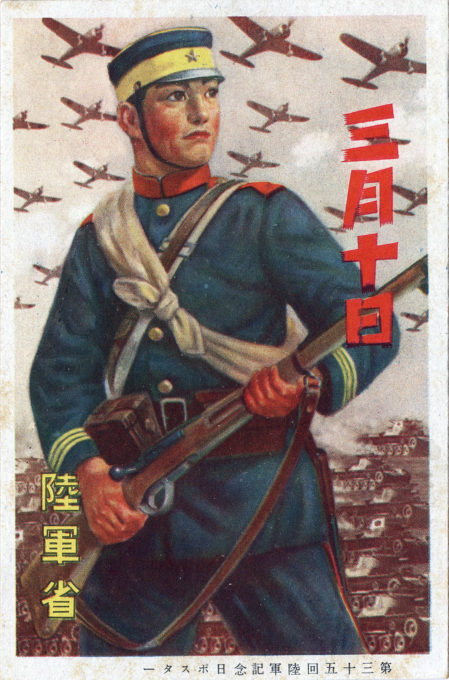
Propaganda postcard reproduction of a 35th Army Day poster, March 10, 1940, as part of the year-long celebration of Japan’s 2600th National Founding Anniversary. Against a backdrop of modern weaponry, the soldier in the foreground is attired in the original infantry uniform designed with the formal creation of a military ministry (Hyōbushō) in 1871 and the establishment in Japan of the first organized regiments and cavalry units based along European lines under the unified control of the national government, not armies commanded by separate clans or domains. Conscription would soon follow in 1873. Army Day was first established to commemorate the Japanese Imperial army victory at the Battle of Mukden (1905) during the Russo-Japanese War.
See also:
Exposition of Shining Technology (2,600th National Foundation Anniversary), 1940.
“Patriotic March” (“Aikoku koshinkyoku”) propaganda postcard, c. 1937.
2600th Anniversary of the Founding of Japan, 1940.
Final Imperial Japanese Navy Fleet Review, 1940.
“A recruit entering the Imperial army in 1936 was one of 240,000 regular active duty soldiers and officers … The peacetime Japanese army, with its two-year conscripted tour of duty, annually turned over about half its members. Compared with the continental European armies, it was a relatively small, 17-division army.
“… Most soldiers in the infantry branch, and each infantry regiment had a tie with a specific locality and had its respective hometown unit. In short, a man did not escape his peers and village by joining the army; they came along, and the consequent motivation not to disgrace one’s family or village by delinquent military service was a powerful one.
“… For most conscripts, [basic training] was a logical progression from the school curricula, which stressed the uniqueness of Japan because of its unbroken Imperial line. The Ministry of Education went to great lengths to ensure that the six years of required schooling had a heavy tinge of nationalism and patriotism throughout the curriculum. Virtues of chukun aikoku (loyalty to the emperor and love of country) were values most brought with them in the army as their intellectual baggage.
“The army, in turn, played on these concepts by claiming a special relationship to the emperor exemplified by the Imperial Rescript to Soldiers and Sailors, which the recruits had to study daily. This was a long, 2,700-character document distinguished by such obscure kanji (Chinese characters) that it was difficult even for college graduates to read. Recruits also had to memorize and recite on command a shorter version of the rescript, the ‘Five Principles of the Soldier’.
“In certain units troops recited the principles in unison before being seated for breakfast. The entire rescript was read to the troops on special occasions such as National Foundation Day (February 11) or Army Day (March 10), but every morning the troops bowed toward the Imperial palace to pay homage to the emperor before they began their arduous daily regimen of training.”
– ”In the Army Barracks of Imperial Japan”, by Edward J. Drea, Armed Forces & Society, Spring 1989


Pingback: “The Battle of the Railway Corps”, 2nd Sino-Japanese War, c. 1940. | Old TokyoOld Tokyo
Pingback: Imperial Japanese Navy officer’s dress uniform, c. 1905. | Old Tokyo